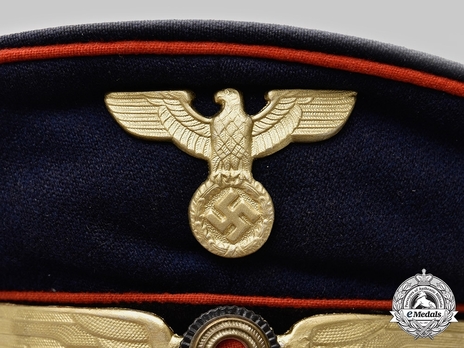Reichsbahn Metal Cap Eagle
SKU: 72.GOR.03.01.01.002
Estimated market value:

Estimated market value:
Attributes
History
The Deutsche Reichsbahn (German National Railway) was created after the First World War in 1920 by combining the formerly independent state railways of the abolished German Empire into a national organisation. Under NSDAP rule, the German state railway system was reorganised in the 1930s to better meet the needs of the economy and to prepare for war, eventually supplying the front lines with soldiers and supplies. The Reichsbahn also had an infamous role to play in the Holocaust, transporting Jews and other “undesirables” to concentration and extermination camps.
The Bahnschutzpolizei (railway protection police) was founded in 1939 as a merger of the Bahnpolizei (railway police) and the Reichsbahnschutz (railway protection force), the latter being regular railway employees that, beyond their normal functions, additionally served as railway security personnel.
The Bahnschutzpolizei as a railway sub-organisation was made up of policemen that were employed by the Reichsbahn rather than the German police force. Their task was to ensure railway safety as well as preventing railway-related espionage and sabotage. During the war, most members of the Bahnschutzpolizei served in the occupied Eastern European territories.
The Reichsbahn-specific metal cap eagle was introduced in October of 1936. It was gold-coloured. Collectibles today often look silvered, however, the reason for this is that the gilding of the insignia has been lost over the decades.
Initially, the eagle emblem measured 36x27mm, but was eventually enlarged to 55x37mm. Compared to the “political” style eagle emblem, it is thicker, the eagle’s wings are shorter, its head faces to the viewer’s left instead of the viewer’s right, the swastika is larger, and it features a noticeable criss-cross pattern on the eagle’s chest.

Versions
N/A


Comments
Sign in to comment and reply.


Scroll Top